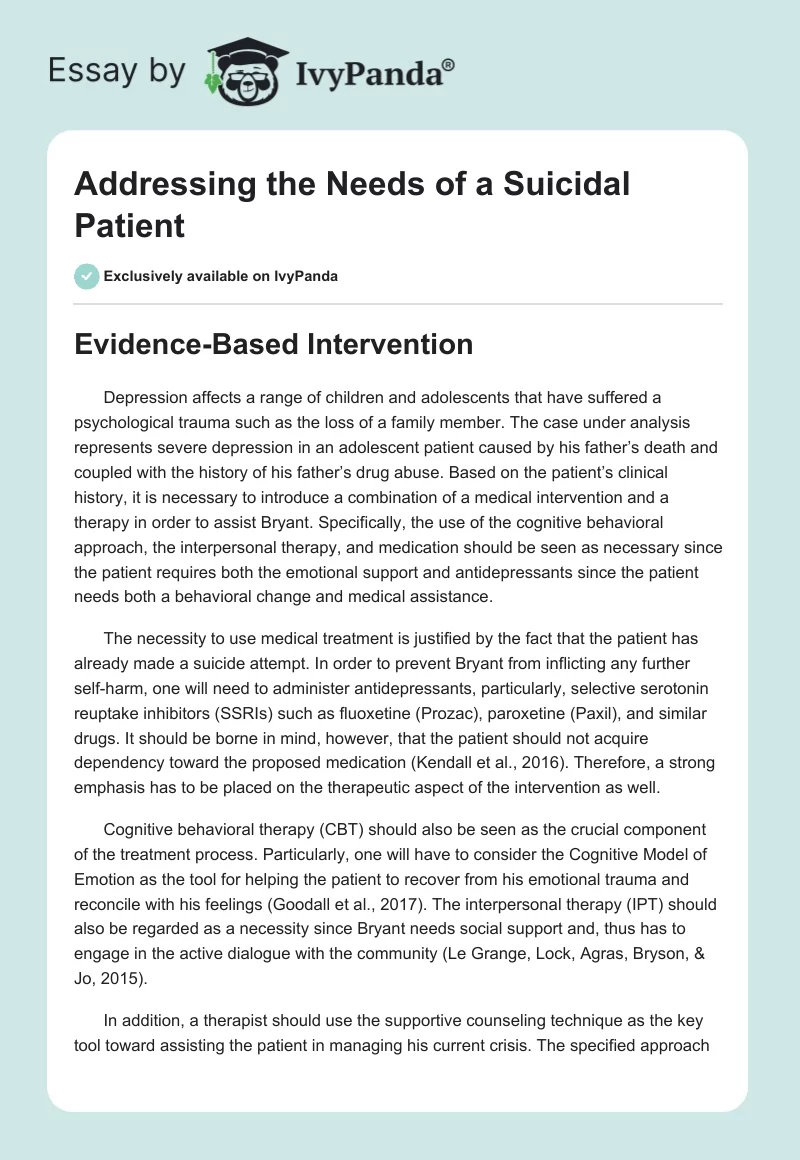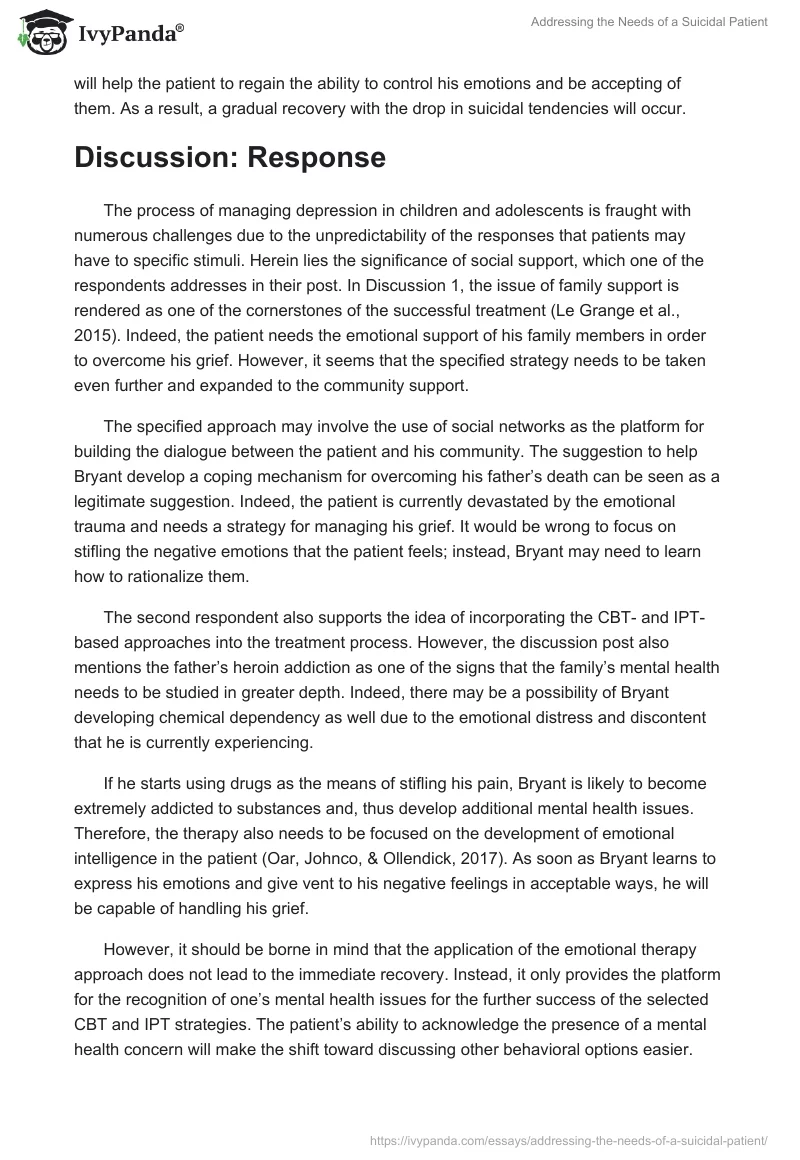Evidence-Based Intervention
Depression affects a range of children and adolescents that have suffered a psychological trauma such as the loss of a family member. The case under analysis represents severe depression in an adolescent patient caused by his father’s death and coupled with the history of his father’s drug abuse. Based on the patient’s clinical history, it is necessary to introduce a combination of a medical intervention and a therapy in order to assist Bryant. Specifically, the use of the cognitive behavioral approach, the interpersonal therapy, and medication should be seen as necessary since the patient requires both the emotional support and antidepressants since the patient needs both a behavioral change and medical assistance.
The necessity to use medical treatment is justified by the fact that the patient has already made a suicide attempt. In order to prevent Bryant from inflicting any further self-harm, one will need to administer antidepressants, particularly, selective serotonin reuptake inhibitors (SSRIs) such as fluoxetine (Prozac), paroxetine (Paxil), and similar drugs. It should be borne in mind, however, that the patient should not acquire dependency toward the proposed medication (Kendall et al., 2016). Therefore, a strong emphasis has to be placed on the therapeutic aspect of the intervention as well.
Cognitive behavioral therapy (CBT) should also be seen as the crucial component of the treatment process. Particularly, one will have to consider the Cognitive Model of Emotion as the tool for helping the patient to recover from his emotional trauma and reconcile with his feelings (Goodall et al., 2017). The interpersonal therapy (IPT) should also be regarded as a necessity since Bryant needs social support and, thus has to engage in the active dialogue with the community (Le Grange, Lock, Agras, Bryson, & Jo, 2015).
In addition, a therapist should use the supportive counseling technique as the key tool toward assisting the patient in managing his current crisis. The specified approach will help the patient to regain the ability to control his emotions and be accepting of them. As a result, a gradual recovery with the drop in suicidal tendencies will occur.
Discussion: Response
The process of managing depression in children and adolescents is fraught with numerous challenges due to the unpredictability of the responses that patients may have to specific stimuli. Herein lies the significance of social support, which one of the respondents addresses in their post. In Discussion 1, the issue of family support is rendered as one of the cornerstones of the successful treatment (Le Grange et al., 2015). Indeed, the patient needs the emotional support of his family members in order to overcome his grief. However, it seems that the specified strategy needs to be taken even further and expanded to the community support.
The specified approach may involve the use of social networks as the platform for building the dialogue between the patient and his community. The suggestion to help Bryant develop a coping mechanism for overcoming his father’s death can be seen as a legitimate suggestion. Indeed, the patient is currently devastated by the emotional trauma and needs a strategy for managing his grief. It would be wrong to focus on stifling the negative emotions that the patient feels; instead, Bryant may need to learn how to rationalize them.
The second respondent also supports the idea of incorporating the CBT- and IPT-based approaches into the treatment process. However, the discussion post also mentions the father’s heroin addiction as one of the signs that the family’s mental health needs to be studied in greater depth. Indeed, there may be a possibility of Bryant developing chemical dependency as well due to the emotional distress and discontent that he is currently experiencing.
If he starts using drugs as the means of stifling his pain, Bryant is likely to become extremely addicted to substances and, thus develop additional mental health issues. Therefore, the therapy also needs to be focused on the development of emotional intelligence in the patient (Oar, Johnco, & Ollendick, 2017). As soon as Bryant learns to express his emotions and give vent to his negative feelings in acceptable ways, he will be capable of handling his grief.
However, it should be borne in mind that the application of the emotional therapy approach does not lead to the immediate recovery. Instead, it only provides the platform for the recognition of one’s mental health issues for the further success of the selected CBT and IPT strategies. The patient’s ability to acknowledge the presence of a mental health concern will make the shift toward discussing other behavioral options easier.
Thus, the emotional therapy process should be seen as the transfer from one stage of the therapy to another. The stage of Bryant’s reconciliation with his emotions should also occur after the patient is provided with family and community support. The opportunities for managing the problem and at the same time reducing the threat of another suicide attempt will emerge (Goodall et al., 2017). The use of the emotional therapy framework will make the transfer from the current state of being mentally devastated to the stage when the patient is enabled to confront his health issue.
References
Goodall, B., Chadwick, I., McKinnon, A., Werner‐Seidler, A., Meiser‐Stedman, R., Smith, P., & Dalgleish, T. (2017). Translating the cognitive model of PTSD to the treatment of very young children: A single case study of an 8‐year‐old motor vehicle accident survivor. Journal of Clinical Psychology, 73(5), 511-523. Web.
Kendall, P. C., Cummings, C. M., Villabø, M. A., Narayanan, M. K., Treadwell, K., Birmaher, B.,… Gosch, E. (2016). Mediators of change in the Child/Adolescent Anxiety Multimodal Treatment Study. Journal of Consulting and Clinical Psychology, 84(1), 1-14. Web.
Le Grange, D., Lock, J., Agras, W. S., Bryson, S. W., & Jo, B. (2015). Randomized clinical trial of family-based treatment and cognitive-behavioral therapy for adolescent bulimia nervosa. Journal of the American Academy of Child & Adolescent Psychiatry, 54(11), 886-894. Web.
Oar, E. L., Johnco, C., & Ollendick, T. H. (2017). Cognitive behavioral therapy for anxiety and depression in children and adolescents. Psychiatric Clinics of North America, 40(4), 661-674. Web.


